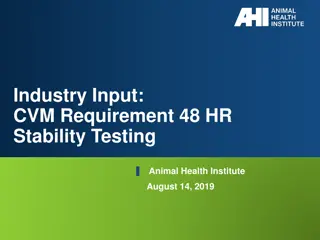Extraction Methods in Pesticide Residue Analysis for Food Safety
Extraction methods play a crucial role in separating pesticide residues from food matrices for analysis. Techniques involve using solvents to efficiently remove pesticides without causing chemical changes. The choice of extraction method depends on the substrate type, with liquid and solid substrates requiring different approaches. For liquid substrates like water and body fluids, techniques such as partitioning and the use of absorbents like activated charcoal are commonly employed. Additionally, liquid-coated or bonded inert solids can also aid in extracting pesticide residues.
Download Presentation

Please find below an Image/Link to download the presentation.
The content on the website is provided AS IS for your information and personal use only. It may not be sold, licensed, or shared on other websites without obtaining consent from the author.If you encounter any issues during the download, it is possible that the publisher has removed the file from their server.
You are allowed to download the files provided on this website for personal or commercial use, subject to the condition that they are used lawfully. All files are the property of their respective owners.
The content on the website is provided AS IS for your information and personal use only. It may not be sold, licensed, or shared on other websites without obtaining consent from the author.
E N D
Presentation Transcript
Pesticide Residues L.4 Food Safety Introduced by Prof .Dr. Tahany Roshdy Abd El Zaher
EXTRACTION METHODS IN PESTICIDE RESIDUE ANALYSIS: Extraction techniques: Extraction means separation of pesticide residues from the matrix by using solvent. The extraction procedure should be such that it quantitatively removes pesticides form matrix (high efficiency), does not cause chemical change in pesticide and use inexpensive and easily cleaned apparatus. The extraction method and solvent type determine the extraction substrates. efficiency from
Choice of extraction method: The main objective behind employing a particular method for a specific substrate is to bring the solvent to close proximity of the pesticide residues for sufficient period so that pesticide residues get solubilized in the solvent. The choice of method depends on the type of substrate and ageing of residues. The substrates in pesticide residue analysis could be liquids like water, fruit juices, body fluids (urine, blood etc.) and solids like soil, flesh, green plant materials (leaves, fruit etc.), dry fodder, grains etc.
1-Liquid substrates: *Partitioning: Samples like water, body fluids, and juices are extracted by partitioning with water immiscible solvent. The addition of sodium chloride in aqueous samples improves the extraction efficiency by reducing the solubility of pesticide in water. It also prevents the emulsion formation, which is frequently partitioning. encountered during
*Use of absorbent: The pesticide residues from aqueous samples can be extracted by passing the sample through solid adsorbents packed in glass column. The adsorbents have high affinity for pesticide molecules, therefore, they are held up on the absorbent whereas water passes out. The solid adsorbents are then extracted with organic solvent. The solid adsorbents normally used for removal of pesticide from aqueous samples are given below:
Solid adsorbents 1. Activated charcoal 2. Polyurethane foam 3. Cellulose triacetate 4. Molecular sieves 5. Ion exchange resins 6. Magnsium Sulphate 7. Silicagel (activated) 8. Florisil and Extrulet
Liquid coated or bonded on inert solids: 1. Carbowax 4000 coated onchromosorb 2. Undecane coated on chromosorb W. 3. RPC-18-HPLC column material 4. RPC-C-8-HPLC column material
2- Solid substrates: Fresh residues Dipping, tumbling, shaking: This method is usually employed for solid substrate when pesticide residues are present on the surface as in case of freshly applied pesticide.
Weathered residues: When sufficient time has elapsed after the application (weathering), the residues are not present on the surface but they penetrate the substrate matrix and are in adsorbed form. The substrate matrix needs to be broken down in fine particles before extraction with solvent. The methods that employ these techniques are macerating/blending, followed extraction, soxhlet extraction. by column
Choice of solvent The choice of solvent for extraction depends on: a)The nature of the substrate. b)The type of pesticide to be extracted. However, the solvent should satisfy the following conditions. * Should have high solubility for the pesticide and least solubility for co-extractives. *Should not change the pesticide chemically or react with it. * Economical * Low boiling. * Easily separated from the substrate. * Compatible to the method of final determination.
The first :Choice of solvent depending on type of substrate: The solvent for extraction of pesticide in different substrate is chosen as follows: Aqueous substrate: Water immiscible solvent like hexane, petroleum ether, benzene, dichloromethane, chloroform, ethyl acetate, etc. Solid substrates: (soil, fodder etc.): Different solvents like acetonitrile, hexane and mixed solvents are used for dry sample with low moisture like grains, samples with high moisture content (green plant samples and substrates with high fat content (grains, oilseeds, egg, meat, fish etc.).
The second: Choice of solvent depending on nature of pesticides: The pesticide molecules can be broadly divided into two group s namely non-ionic and ionic type. The non-ionic pesticides also differ in their polarity. For nonionic type of pesticides, organic solvents with varying polarity depending on the polarity of pesticide molecules are employed.
Recent techniques of extraction 1-Liquid-liquid Extraction (LLE) Analytes in solutions or liquid samples can be extracted by direct partitioning with an immiscible solvent. Liquid-liquid extraction (LLE) is based on the relative solubility of an analyte in two immiscible phases and is governed distribution/partition coefficient. Extraction of an analyte is achieved by the differences in the solubilising power (polarity) of the two immiscible liquid phases. L by the equilibrium
LLE is traditionally one of the most common methods of extraction, particularly for organic compounds from aqueous matrices. Typically a separating funnel is used and the two immiscible phases are mixed by shaking and then allowed to separate. To avoid emulsions, in some cases, a salt may be added and centrifugation can be used if necessary. Alternatively a matrix solid- phase dispersion(MSPD) approach can be used to avoid emulsions. Both layers can be collected for further analysis. To ensure the complete extraction of an analyte into the required phase, multiple extractions may be necessary. Due to the limited selectivity, particularly for trace level analysis, there is a need for cleanup or analyte enrichment and concentration steps prior to instrumental analysis.
2: Solid Phase Extraction (SPE): Solid phase extraction technique is based on the concept of selective retention by the device for the analytic, in this case the pesticide. SPE can be made to work on either the batch or column mode. This method has not become popular as there is loss of the pesticide as it tends to adhere to the surface of the beaker and tubes. The method is modified by the use of adsorbents contained in cartridges of various sizes usually made of plastic such as polyethylene or polypropylene of extremely high purity and is termed as column-liquid solid extraction (CLSE), however for simplicity it is referred to a SPE cartridges
An SPE method always consists of three to four successive steps. 1. First, the solid sorbent should be conditioned using an appropriate solvent. This step is crucial, as it enables the wetting of the packing material and the solvation of the functional groups. In addition, it removes possible impurities initially contained in the sorbent or the packaging. Also, this step removes the air present in the column and fills the void volume with solvent. The nature of the conditioning solvent depends on the type of the solid sorbent. Typically, for reversed phase sorbent, methanol is frequently used, followed by water or an aqueous buffer whose pH and ionic strength are similar to that of the sample. Precautionary steps are taken to prevent the solid sorbent from drying in between the conditioning and the sample treatment steps, otherwise the analytes will not be efficiently retained giving rise to poor recoveries. If the sorbent is dry for more than several minutes, it must be reconditioned.
The second step is the percolation of the sample through the solid sorbent. Depending on the system used, the volumes used can range from 1 mL to 1 L. The sample may be applied to the column by gravity, pumping, aspirated by vacuum or by an automated system. The sample flow rate through the sorbent should be low enough to enable efficient retention of the analytes, and high enough to avoid excessive retention. During this step, the analytes are concentrated on the sorbent. Even though the matrix components may also be retained by the solid sorbent, some of them could pass through, thus enabling some purification (matrix separation) of the sample.
The third step (which is optional) may be the washing of the solid sorbent with an appropriate solvent, having low elution strength, to eliminate matrix components which have been retained by the solid sorbent, without displacing the analytes. A drying step may also be advisable, especially for aqueous matrices, to remove traces of water from the solid sorbent. This will eliminate the presence of water in the final extract, which, in some cases, may hinder the subsequent concentration of the extract and the analysis.
The final step is the elution of the analytes of interest by an appropriate solvent, without removing the retained matrix components. The solvent volume should be adjusted so that quantitative recovery of the analytes is achieved with a subsequent low dilution. In addition, the flow rate should be correctly adjusted to ensure efficient elution. It is often recommended that the solvent volume be fractionated into two aliquots, and to allow the solvent to soak into the solid sorbent before the elution.
3: Solid Phase Micro-Extraction (SPME): In this technique a droplet of extractant, or a fiber coated with the extractant is suspended in the solution to be extracted and then transferred to an analytical device. 4:Accelerated Solvent Extraction (ASE) The extracting solvent is passed under amabient temperature or pressure through the matrix, removing the analytic using a smaller volume of the solvent.
5: Microwave-Assisted Solvent Extraction (MASE): The technique employs the use of microwave energy and a suitable solvent to extract the analytic from the matrix, water is commonly preferred solvent in this procedure. 6: Supercriticial Fluid Extraction (SFE) In the supercritical fluid extraction (SFE) method carbon dioxide gas is passed under supercritical temperature and pressure (liquefied carbon dioxide) through the matrix to extract the pesticide and then transferred to the analytical device for quantitation.
7: Stir-Bar Sorptive Extraction (SBSE): SBSE was first developed for sampling in liquid phase and is based upon sorption of the investigated analytic or fraction onto a very thick film of PDMS coated onto a glass-coated magnetic stir bar (commercially known as Twister, Gerstel GmbH, and Mulheim, Germany). Sampling is done by directly introducing the SBSE device into the aqueous sample; in the original experiments, the analytic sampled for a given time were recovered by thermal desorption and then on-line transferred to a gas chromatography (GC) or GC mass spectrometry (MS) system for analysis. Later, liquid desorption in performance liquid chromatography (HPLC) also was applied, mainly for analytes not analyzable by GC. combination with high
Stir-Bar Sorptive Extraction
BASIC CONCEPTS OF SBSE: SBSE is based upon sorption, which is a form of partition based upon the analytes dissolution in a liquid-retaining polymer from a liquid or vapour sample, thus, originating a bulk retention. The main advantages of sorption are related to high inertness of PDMS, which gives better performance for labile, polar, or reactive compounds; absence of reactions; analyte recovery mechanism based upon a well-known chromatographic process; and linearity of sorption isotherms, which is fundamental for quantitative analysis. catalytic degradation






















